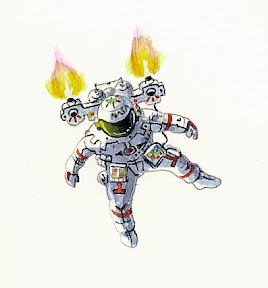Written by Corey S. Powell
 Exploding boobs, toilet target practice, the second birth…
Exploding boobs, toilet target practice, the second birth…
1 Nearly every astronaut experiences some space sickness, caused by the wildly confusing information reaching their inner ears. In addition to nausea, symptoms include headaches and trouble locating your own limbs. Just like college, really.
2 And those are the least of your worries. In weightlessness, fluids shift upward, causing nasal congestion and a puffy face; bones lose calcium, forming kidney stones; and muscles atrophy, slowing the bowels and shrinking the heart.
3 At least you’ll be puffy, constipated, and tall: The decreased pressure on the spine in zero-g causes most space travelers to grow about two inches.
4 Lab rats sent into space during midpregnancy, while their fetuses’ inner ears are developing, spawn some seriously tipsy babies (pdf).
5 No humans have yet been conceived in space, so we can only imagine.
6 So that’s what it takes: A 2001 study showed that astronauts who snored on Earth snoozed silently in space.
7 But astronauts sleep less soundly; 16 sunrises a day throws a major wrench into their circadian rhythms.
8 And Ziggy played guitar. At the start of the workday on the space shuttle, mission control in Houston broadcasts wake-up music, usually selected with a particular astronaut in mind. On the all-work, no-play International Space Station, crews wake to an alarm clock.
9 If you are ever exposed to the vacuum of space without a suit on, don’t hold your breath: Sudden decompression would cause your lungs to rupture.
10 In addition, water on the tongue, in the nose, and in the eyes would boil away. This actually happened in 1965, when a space suit failed during a NASA experiment and the tester was exposed to a near vacuum for 15 seconds.
11 Contrary to Hollywood, though, you wouldn’t explode. Lack of oxygen in the blood is what would kill you, but it would take about two minutes.
12 More explosion paranoia: Virgin Galactic, Richard Branson’s space-tourism company, reportedly considered barring women with breast implants due to fears that they might blow up.
13 John Glenn found it hard to choke down his food, but not because of the lack of gravity: Early astronauts relied on aluminum tubes of semiliquid mush, food cubes, and dehydrated meals.
14 Today astronauts can spice up their meals with salt and pepper-in liquid form. Sprinkled grains would float away, tickling noses and clogging vents.
15 Missing something? Those vents on the space shuttle and International Space Station serve as the lost and found, sucking up anything that’s floating about unsecured.
16 The shuttle commode requires that astronauts align themselves precisely in the dead center of the seat. A mock-up of the shuttle toilet, complete with built-in camera, is used to train them how to position themselves.
17 NASA tried building a bathroom into its space suits-a fitted condom attached to a bladder for men, a molded gynecological insert for women-but gave up and passed out diapers to all.
18 Returning astronauts report extreme difficulty moving their arms and legs right after touchdown, one reason why they call landing “the second birth.”
19 But some long-duration cosmonauts report that the hardest thing to readjust to about life on Earth is that when you let go of objects, they fall.
20 Better just to stay up there? Eighteen people have died on space missions, but never in space-always on the way up or the way down.
Very interesting. I love accumulating random facts that I will never use in real life. Thanks.